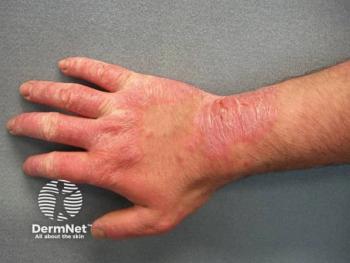
FDA Approves Sun Pharma's New LED BLU-U Device for AK
Key Takeaways
- The LED BLU-U device replaces fluorescent tubes with LED technology, maintaining the same clinical mechanism for treating actinic keratoses.
- Design improvements include a 5-panel shape, compact footprint, and optimized LED arrangement, enhancing patient comfort and usability.
Sun Pharma's innovative BLU-U device gains FDA approval, revolutionizing actinic keratosis treatment with advanced blue light therapy.
Today, Sun Pharmaceutical announced the US Food and Drug Administration (FDA) approval of its next-generation BLU-U Blue Light Photodynamic Therapy (PDT) Illuminator. This updated device incorporates light-emitting diode (LED) technology, replacing the previous model’s fluorescent tubes. The newly approved model, referred to as LED BLU-U, is used in combination with levulan kerstick (aminolevulinic acid HCl) topical solution, 20%, and is indicated for the treatment of minimally to moderately thick actinic keratoses (AK) on the face, scalp, or upper extremities.1
"As physicians, our goal is to put ourselves out of business by treating and curing disease. As a dermatologic surgeon, I prefer to treat AK's before they become skin cancer," said Dermatology Times Editorial Advisory Board Member Aaron Farberg, MD, FAAD, in a recent interview. "The approval of the new illuminator is advancing the technology and treatment of field therapy of AK's with PDT. It demonstrates a commitment to our field and allows us to best help our dermatology patients.
Technological Advancements and Clinical Utility
The updated LED BLU-U system has retained the original therapeutic indication but introduces several design improvements. The new configuration features a 5-panel shape for increased flexibility and a more ergonomic design. Additional enhancements include a more compact footprint, reduced weight, and an optimized LED arrangement. These changes are intended to improve both patient comfort and the usability of the device for healthcare providers, particularly dermatologists.
Importantly, while the light delivery system has shifted from fluorescent tubes to LED technology, the clinical mechanism of action remains the same. The system activates the topical photosensitizer (levulan kerstick), which is selectively absorbed by AK lesions. Upon light exposure, reactive oxygen species are generated, resulting in localized cytotoxic effects and lesion clearance. The new LED configuration is expected to provide more consistent light distribution, possibly enhancing treatment precision and overall outcomes.
Importantly, while the light delivery system has shifted from fluorescent tubes to LED technology, the clinical mechanism of action remains the same. The system activates the topical photosensitizer (levulan kerstick), which is selectively absorbed by AK lesions. Upon light exposure, reactive oxygen species are generated, resulting in localized cytotoxic effects and lesion clearance. The new LED configuration is expected to provide more consistent light distribution, possibly enhancing treatment precision and overall outcomes.
Regulatory Pathway and Approval Process
The FDA granted premarket approval (PMA) for the LED BLU-U under its Real-Time Review Program. This pathway allows for an expedited evaluation of high-quality submissions, reflecting a collaborative and efficient regulatory process. The Real-Time Review designation is generally reserved for applications with complete datasets and clearly defined endpoints, suggesting a robust submission from Sun Pharma.
Abhay Gandhi, CEO of Sun Pharma North America, emphasized the company’s commitment to innovation in dermatology. "We are pleased to receive the FDA's approval of LED BLU-U and look forward to seeing the positive impact this next generation device will have for those living with AK," Gandhi said in a news release. "As a company committed to innovation, we are confident that this new LED BLU-U model will provide improved efficiency and reliability while maintaining the safety and efficacy that healthcare professionals and people with AKs have come to trust from Sun Pharma."
Clinical Context
AK lesions, while benign initially, have the potential to progress to squamous cell carcinoma if left untreated. They typically manifest on sun-exposed areas such as the face, scalp, and upper limbs.2
Current management strategies for AK include cryotherapy, topical chemotherapeutics, and photodynamic therapy. PDT offers a non-invasive treatment option that selectively targets abnormal keratinocytes, minimizing damage to surrounding healthy tissue. The levulan kerstick + BLU-U system has been a mainstay in PDT for over 2 decades, recognized for its safety profile and efficacy in clearing AK lesions in as few as 1 to 2 sessions.
Commercial and Clinical Implications
The next-generation LED BLU-U device represents a step forward in photodynamic therapy. The introduction of LED technology not only modernizes the device but also potentially improves operational efficiency and treatment reproducibility. Additionally, its reduced size and weight make it more feasible for integration into a wider range of dermatology practice settings.
Conclusion
The FDA’s approval of the LED BLU-U system reinforces the ongoing evolution of PDT and highlights Sun Pharma’s role in advancing treatment options for patients with AK. Further post-market surveillance and real-world data will be instrumental in validating the long-term clinical benefits of this newly approved technology.
References
- Sun Pharma announces FDA approval of next generation BLU-U® blue light photodynamic therapy illuminator for actinic keratosis. News release. PR Newswire. Published May 16, 2025. Accessed May 16, 2025.
https://www.prnewswire.com/news-releases/sun-pharma-announces-fda-approval-of-next-generation-blu-u-blue-light-photodynamic-therapy-illuminator-for-actinic-keratosis-302457770.html - Marques E, Chen TM. Actinic keratosis. In: StatPearls. Treasure Island (FL): StatPearls Publishing; August 17, 2023.
Newsletter
Like what you’re reading? Subscribe to Dermatology Times for weekly updates on therapies, innovations, and real-world practice tips.



















